Hydrological Functioning and Water Availability in a Himalayan Karst Basin under Climate Change
Abstract
1. Introduction
2. Materials and Methods
2.1. Study Area
2.2. Data Acquisition
2.3. Data Analysis
2.3.1. Snow Cover
2.3.2. Statistical Time-Series Analysis
2.3.3. Machine-Learning Models
Random Forest Regression
Support Vector Regression
Hyperparameter Selection
2.3.4. Prediction of Spring Stage in 2030
3. Results
3.1. Summary Statistics
3.2. Autocorrelation and Cross-Correlation
3.3. Machine-Learning Model Results
3.4. Model Prediction for IPCC Climate Change Scenarios
4. Discussion
4.1. Analysis of Spring Hydrology
4.2. Comparing Performances of RFR and SVR Models
4.3. Long-Term Water Availability under Regional Climate-Change Scenarios
5. Conclusions
Supplementary Materials
Author Contributions
Funding
Data Availability Statement
Conflicts of Interest
References
- Goldscheider, N.; Chen, Z.; Auler, A.S.; Bakalowicz, M.; Broda, S.; Drew, D.; Hartmann, J.; Jiang, G.; Moosdorf, N.; Stevanovic, Z.; et al. Global distribution of carbonate rocks and karst water resources. Hydrogeol. J. 2020, 28, 1661–1677. [Google Scholar] [CrossRef]
- Ford, D.; Williams, P. Karst Hydrogeology and Geomorphology; John Wiley & Sons: New York, NY, USA, 2007. [Google Scholar]
- Kiraly, L. Karstification and groundwater flow. In Evolution of Karst: From Prekarst to Cessation; Gabrovšek, F., Ed.; Založba ZRC: Postojna, Slovenia, 2002; pp. 155–190. [Google Scholar]
- Goldscheider, N.; Drew, D. Methods in Karst Hydrogeology; Taylor and Francis: London, UK, 2007. [Google Scholar]
- Taminskas, J.; Marcinkevicius, V. Karst geoindicators of environmental change: The case of Lithuania. Environ. Geol. 2002, 42, 757–766. [Google Scholar] [CrossRef]
- Guo, Q.; Wang, Y.; Ma, T.; Li, L. Variation of karst spring discharge in the recent five decades as an indicator of global climate change: A case study at Shanxi, northern China. Sci. China Ser. D-Earth Sci. 2005, 48, 2001–2010. [Google Scholar] [CrossRef]
- Hartmann, A.; Goldscheider, N.; Wagener, T.; Lange, J.; Weiler, M. Karst water resources in a changing world. Rev. Geophys. 2014, 52, 218–242. [Google Scholar] [CrossRef]
- Intergovernmental Panel on Climate Change. Summary for policymakers. In Climate Change 2021—The Physical Science Basis: Contribution of Working Group I to the Sixth Assessment Report of the Intergovernmental Panel on Climate Change; Masson-Delmotte, V., Zhai, P., Pirani, A., Connors, S.L., Péan, C., Berger, S., Caud, N., Chen, Y., Goldfarb, L., Gomis, M.I., et al., Eds.; Cambridge University Press: Cambridge, UK; New York, NY, USA, 2021. [Google Scholar]
- Verma, O. Climate change and its impacts with special reference to India. In Water, Cryosphere, and Climate Change in the Himalayas; Taloor, A.K., Kotlia, B.S., Kumar, K., Eds.; Springer: Cham, Switzerland, 2021. [Google Scholar] [CrossRef]
- Jeelani, G.; Bhat, N.A.; Shivanna, K.; Bhat, M.Y. Geochemical characterization of surface water and spring water in SE Kashmir Valley, western Himalaya: Implications to water–rock interaction. J. Earth Syst. Sci. 2011, 120, 921–932. [Google Scholar] [CrossRef]
- Jeelani, G.; Shah, R.A.; Deshpande, R.D.; Fryar, A.E.; Perrin, J.; Mukherjee, A. Distinguishing and estimating recharge to karst springs in snow and glacier dominated mountainous basins of the western Himalaya, India. J. Hydrol. 2017, 550, 239–252. [Google Scholar] [CrossRef]
- Jeelani, G.; Shah, R.A.; Fryar, A.E.; Deshpande, R.D.; Mukherjee, A.; Perrin, J. Hydrological processes in glacierized high-altitude basins of the western Himalayas. Hydrogeol. J. 2018, 26, 615–628. [Google Scholar] [CrossRef]
- Jeelani, G.; Feddema, J.J.; Veen, C.J.; Stearns, L. Role of snow and glacier melt in controlling river hydrology in Liddar watershed (western Himalaya) under current and future climate. Water Resour. Res. 2012, 48. [Google Scholar] [CrossRef]
- Jeelani, G.; Bhat, N.A.; Shivanna, K. Use of δ18O tracer to identify stream and spring origins of a mountainous catchment: A case study from Liddar watershed, Western Himalaya, India. J. Hydrol. 2010, 393, 257–264. [Google Scholar] [CrossRef]
- Lone, S.A.; Jeelani, G.; Deshpande, R.D.; Shah, R.A. Evaluating the sensitivity of glacier to climate by using stable water isotopes and remote sensing. Environ. Earth Sci. 2017, 76, 598. [Google Scholar] [CrossRef]
- Lone, S.A.; Jeelani, G.; Alam, A.; Bhat, M.S.; Farooqi, H. Effects of changing climate on the water resources of upper Jhelum basin (UJB), India. In Riverine Systems: Understanding the Hydrological, Hydrosocial and Hydroheritage Connections; Mukherjee, A., Ed.; Springer-Capital Publishing: New Delhi, India, 2021; pp. 139–154. [Google Scholar]
- Shah, R.A.; Jeelani, G.; Goldscheider, N. Karst geomorphology, cave development, and hydrogeology in the Kashmir valley, Western Himalaya, India. Acta Carsologica 2018, 47, 5–21. [Google Scholar] [CrossRef]
- Hu, C.; Hao, Y.; Yeh, T.-C.J.; Pang, B.; Wu, Z. Simulation of spring flows from a karst aquifer with an artificial neural network. Hydrol. Process. 2008, 22, 596–604. [Google Scholar] [CrossRef]
- Paleologos, E.K.; Skitzi, I.; Katsifarakis, K.; Darivianakis, N. Neural network simulations of spring flow in karst environments. Stoch. Env. Res. Risk A. 2013, 27, 1829–1837. [Google Scholar] [CrossRef]
- Jeannin, P.-Y.; Artigue, G.; Butscher, C.; Chong, Y.; Charlier, J.-B.; Duran, L.; Gill, L.; Hartmann, A.; Johannet, A.; Jourde, H.; et al. Karst modelling challenge 1: Results of hydrological modelling. J. Hydrol. 2021, 600, 126508. [Google Scholar] [CrossRef]
- Wunsch, A.; Liesch, T.; Cinkus, G.; Ravbar, N.; Chen, Z.; Mazzilli, N.; Jourde, H.; Goldscheider, N. Karst spring discharge modeling based on deep learning using spatially distributed input data. Hydrol. Earth Syst. Sci. 2022, 26, 2405–2430. [Google Scholar] [CrossRef]
- Goyal, M.K.; Sharma, A.; Katsifarakis, K.L. Prediction of flow rate of karstic spring using support vector machine. Hydrol. Sci. J. 2017, 62, 2175–2186. [Google Scholar] [CrossRef]
- Mangin, A. Pour une meilleure connaissance des systèmes hydrologiques à partir des analyses corrélatoire et spectrale. J. Hydrol. 1984, 67, 25–43. [Google Scholar] [CrossRef]
- Padilla, A.; Pulido-Bosch, A. Study of hydrographs of karstic aquifers by means of correlation and cross-spectral analysis. J. Hydrol. 1995, 68, 73–89. [Google Scholar] [CrossRef]
- Labat, D.; Ababou, R.; Mangin, A. Rainfall–runoff relations for karstic springs. Part II: Continuous wavelet and discrete orthogonal multiresolution analyses. J. Hydrol. 2000, 238, 149–178. [Google Scholar] [CrossRef]
- Labat, D.; Masbou, J.; Beaulieu, E.; Mangin, A. Scaling behavior of the fluctuations in stream flow at the outlet of karstic watersheds, France. J. Hydrol. 2011, 410, 162–168. [Google Scholar] [CrossRef]
- Malik, M.I.; Bhat, M.S.; Najar, S.A. Remote sensing and GIS based groundwater potential mapping for sustainable water resource management of Lidder catchment in Kashmir Valley, India. J. Geol. Soc. India 2016, 87, 716–726. [Google Scholar] [CrossRef]
- Jeelani, G.; Kumar, U.S.; Bhat, N.A.; Sharma, S.; Kumar, B. Variation of δ18O, δD and 3H in karst springs of south Kashmir, western Himalayas (India). Hydrol. Process. 2015, 29, 522–530. [Google Scholar] [CrossRef]
- Middlemiss, C.S. Revision of Silurian-Trias sequence of Kashmir. Rec. Geol. Surv. India 1910, 40, 206–260. [Google Scholar]
- Coward, J.M.H.; Waltham, A.C.; Bowser, R.J. Karst springs in the valley of Kashmir. J. Hydrol. 1972, 16, 213–223. [Google Scholar] [CrossRef]
- Wadia, D.N. Geology of India, 4th ed.; Tata McGraw Hill: New Delhi, India, 1975. [Google Scholar]
- Karra, K.; Kontgis, C.; Statman-Weil, Z.; Mazzariello, J.C.; Mathis, M.; Brumby, S.P. Global land use/land cover with Sentinel 2 and deep learning. In Proceedings of the 2021 IEEE International Geoscience and Remote Sensing Symposium, Brussels, Belgium, 11–16 July 2021; IEEE: New York, NY, USA, 2021; pp. 4704–4707. [Google Scholar] [CrossRef]
- U.S. Geological Survey. EarthExplorer. Available online: https://earthexplorer.usgs.gov/ (accessed on 12 April 2023).
- R Core Team. R: A Language and Environment for Statistical Computing; R Foundation for Statistical Computing: Vienna, Austria, 2022. [Google Scholar]
- Di Marco, N.; Righetti, M.; Avesani, D.; Zaramella, M.; Notarnicola, C.; Borga, M. Comparison of MODIS and model-derived snow-covered areas: Impact of land use and solar illumination conditions. Geosciences 2020, 10, 134. [Google Scholar] [CrossRef]
- Dietz, A.J.; Kuenzer, C.; Gessner, U.; Dech, S. Remote sensing of snow—A review of available methods. Int. J. Remote Sens. 2012, 33, 4094–4134. [Google Scholar] [CrossRef]
- Hall, D.K.; Riggs, G.A.; Salomonson, V.V. Development of methods for mapping global snow cover using moderate resolution imaging spectroradiometer data. Remote Sens. Environ. 1995, 54, 127–140. [Google Scholar] [CrossRef]
- Miao, J.; Liu, G.; Cao, B.; Hao, Y.; Chen, J.; Yeh, T.-C.J. Identification of strong karst groundwater runoff belt by cross wavelet transform. Water Resour. Manag. 2014, 28, 2903–2916. [Google Scholar] [CrossRef]
- Egbers, R. Sentinel-2 Data Processing and Identifying Glacial Features in Sentinel-2 Imagery. Bachelor’s Thesis, Delft University of Technology, Delft, The Netherlands, 2016. [Google Scholar]
- Tong, R.; Parajka, J.; Komma, J.; Blöschl, G. Mapping snow cover from daily Collection 6 MODIS products over Austria. J. Hydrol. 2020, 590, 125548. [Google Scholar] [CrossRef]
- Yan, D.; Huang, C.; Ma, N.; Zhang, Y. Improved Landsat-based water and snow indices for extracting lake and snow cover/glacier in the Tibetan Plateau. Water 2020, 12, 1339. [Google Scholar] [CrossRef]
- Stillinger, T.; Roberts, D.A.; Collar, N.M.; Dozier, J. Cloud masking for Landsat 8 and MODIS Terra over snow-covered terrain: Error analysis and spectral similarity between snow and cloud. Water Resour. Res. 2019, 55, 6169–6184. [Google Scholar] [CrossRef]
- Larocque, M.; Mangin, A.; Razack, M.; Banton, O. Contribution of correlation and spectral analyses to the regional study of a large karst aquifer. J. Hydrol. 1998, 205, 217–231. [Google Scholar] [CrossRef]
- Liu, L.; Chen, X.; Xu, G.; Shu, L. Use of hydrologic time-series data for identification of hydrodynamic function and behavior in a karstic water system in China. Hydrogeol. J. 2011, 19, 1577–1585. [Google Scholar] [CrossRef]
- Kovačič, G. Hydrological study of the Malenščica Karst Spring (SW Slovenia) by means of a time series analysis. Acta Carsologica 2009, 39, 201–215. [Google Scholar] [CrossRef]
- Herman, E.K.; Toran, L.; White, W.B. Quantifying the place of karst aquifers in the groundwater to surface water continuum: A time series analysis of storm behavior in Pennsylvania water resources. J. Hydrol. 2009, 376, 307–317. [Google Scholar] [CrossRef]
- Panagopoulos, G.; Lambrakis, N. The contribution of time series analysis to the study of the hydrodynamic characteristics of the karst system: Application on two typical karst aquifers of Greece. J. Hydrol. 2006, 329, 368–376. [Google Scholar] [CrossRef]
- Li, P.; Chen, P.; Shen, J.; Deng, W.; Kang, X.; Wang, G.; Zhou, S. Dynamic monitoring of desertification in Ningdong based on Landsat images and machine learning. Sustainability 2022, 14, 7470. [Google Scholar] [CrossRef]
- Pacheco, A.d.P.; da Silva, J.A., Jr.; Ruiz-Armenteros, A.M.; Henriques, R.F.F. Assessment of k-nearest neighbor and random forest classifiers for mapping forest fire areas in central Portugal using Landsat-8, Sentinel-2, and Terra imagery. Remote Sens. 2021, 13, 1345. [Google Scholar] [CrossRef]
- Tyralis, H.; Papacharalampous, G.; Langousis, A. A brief review of random forests for water scientists and practitioners and their recent history in water resources. Water 2019, 11, 910. [Google Scholar] [CrossRef]
- Vapnik, V. The support vector method of function estimation. In Nonlinear Modeling; Suykens, J.A.K., Vandewalle, J., Eds.; Springer: Boston, MA, USA, 1999; pp. 55–85. [Google Scholar] [CrossRef]
- Granata, F.; Papirio, S.; Esposito, G.; Gargano, R.; De Marinis, G. Machine learning algorithms for the forecasting of wastewater quality indicators. Water 2017, 9, 105. [Google Scholar] [CrossRef]
- Amaranto, A.; Mazzoleni, M. B-AMA: A Python-coded protocol to enhance the application of data-driven models in hydrology. Environ. Modell. Softw. 2023, 160, 105609. [Google Scholar] [CrossRef]
- Rodriguez-Galiano, V.; Sanchez-Casillo, M.; Chica-Olmo, M.; Chica-Rivas, M. Machine learning predictive models for mineral prospectivity: An evaluation of neural networks, random forest, regression trees and support vector machines. Ore Geol. Rev. 2015, 71, 804–818. [Google Scholar] [CrossRef]
- O’Neill, B.C.; Kriegler, E.; Ebi, K.L.; Kemp-Benedict, E.; Riahi, K.; Rothman, D.S.; van Ruijven, B.J.; van Vuuren, D.P.; Birkmann, J.; Kok, K.; et al. The roads ahead: Narratives for shared socioeconomic pathways describing world futures in the 21st century. Global Environ. Chang. 2017, 42, 169–180. [Google Scholar] [CrossRef]
- Intergovernmental Panel on Climate Change. IPCC WGI Interactive Atlas. Available online: https://interactive-atlas.ipcc.ch/ (accessed on 12 April 2023).
- Shah, R.A.; Jeelani, G.; Jacob, N. Estimating mean residence time of karst groundwater in mountainous catchments of Western Himalaya, India. Hydrol. Sci. J. 2017, 62, 1230–1242. [Google Scholar] [CrossRef]
- Intergovernmental Panel on Climate Change. Climate Change 2007—Impacts, Adaptation and Vulnerability: Contribution of Working Group II to the Fourth Assessment Report of the Intergovernmental Panel on Climate Change; Parry, M., Canziani, O., Palutikof, J., van der Linden, P., Hanson, C., Eds.; Cambridge University Press: Cambridge, UK, 2007. [Google Scholar]
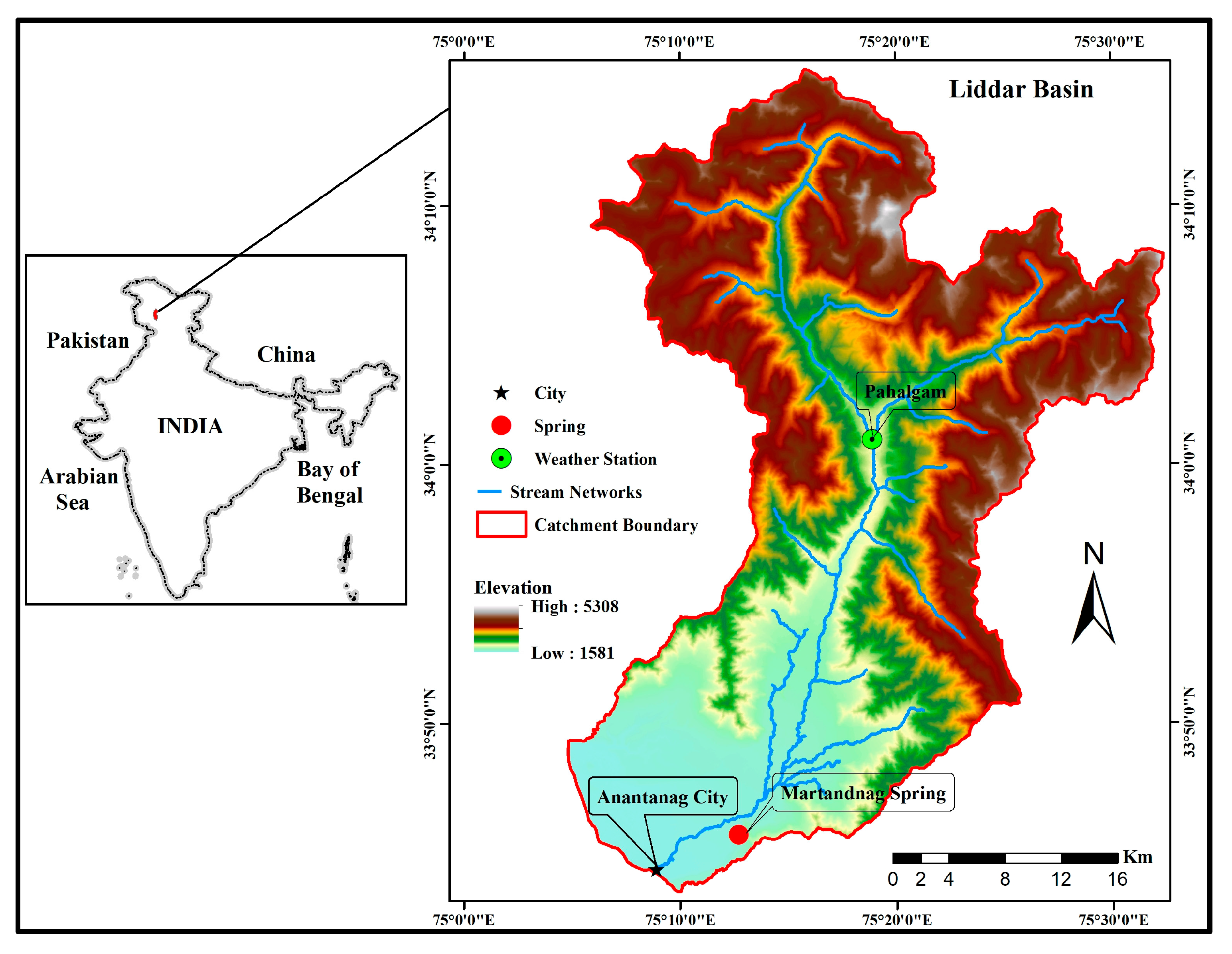
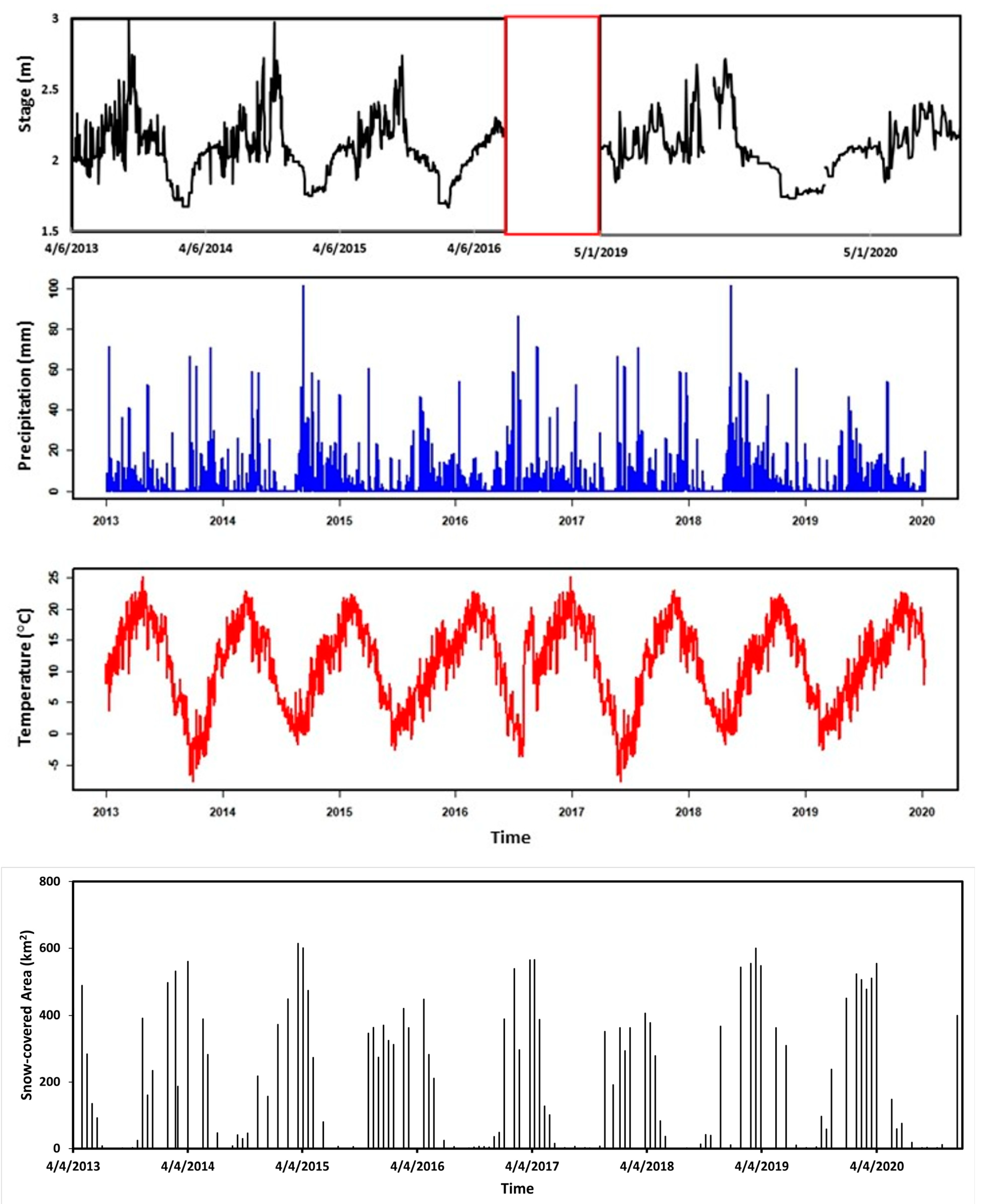

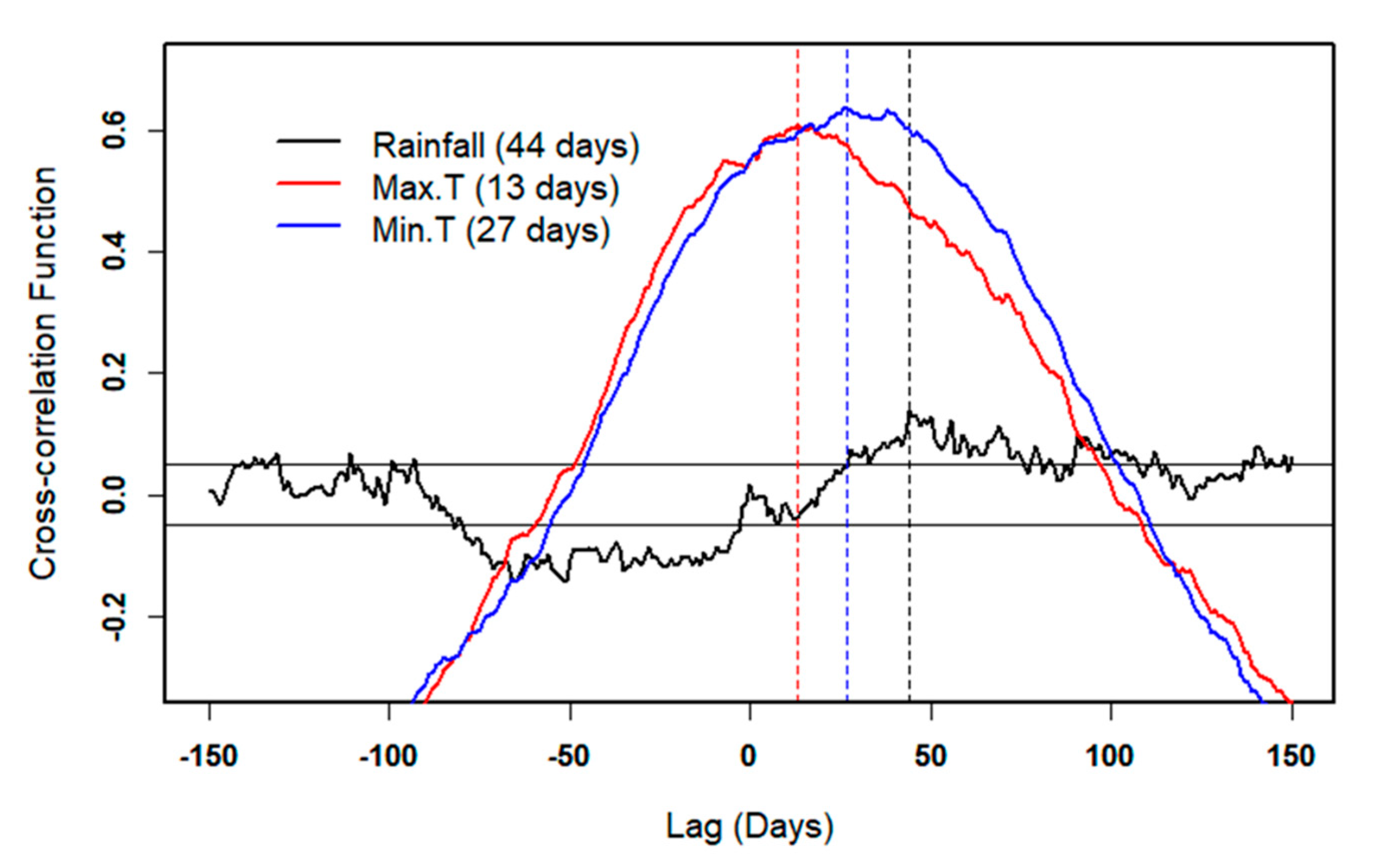
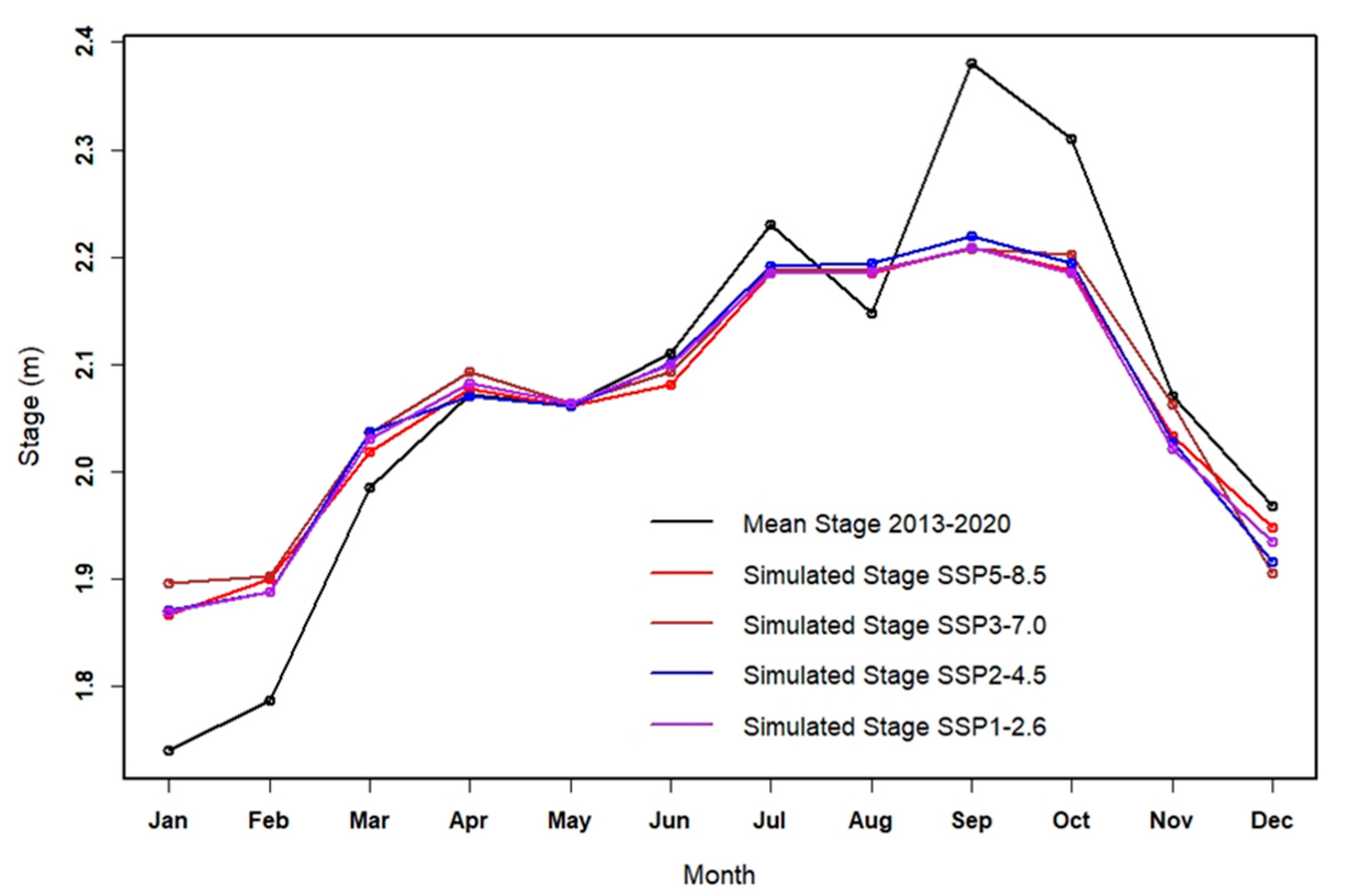
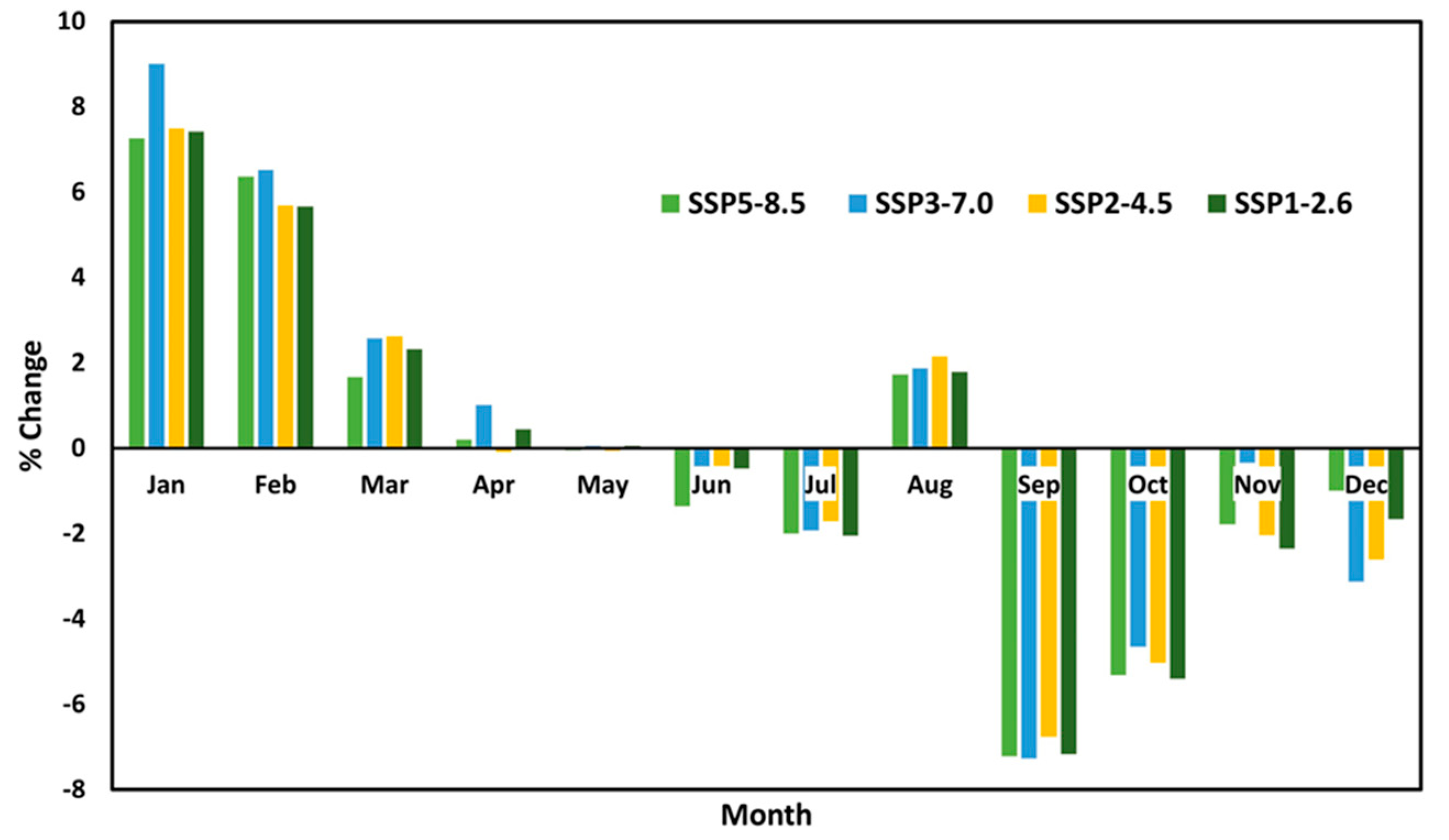
| Hydrometeorological Data | ||||
| Site | Data Type | Units | Time Resolution | Period |
| Martandnag spring Pahalgam | Stage | m | Hourly | 2013–2016, 2019–2020 |
| Rainfall, air temperature | mm, °C | Daily | 2013–2020 | |
| Satellite Data | ||||
| Name | Number of Bands | Spatial Resolution | Zone | Period |
| Landsat 8 OLI/TIRS S2SP | 11 | 30 m | UTM zone 45 N | 2013–2020 |
| Parameter | Mean | Std. Error | Med. | Max. | Min. | n |
|---|---|---|---|---|---|---|
| Stage (m) | 2.07 | 0.01 | 2.05 | 3.00 | 1.67 | 1653 |
| Rainfall (mm) | 3.64 | 0.19 | 0 | 115.2 | 0 | 2424 |
| Max. air T (°C) | 16.99 | 0.16 | 18.50 | 30.3 | −2 | 2424 |
| Min. air T (°C) | 3.71 | 0.14 | 3.90 | 20.2 | −14.7 | 2424 |
| Mean air T (°C) | 10.35 | 0.14 | 11.20 | 25.2 | −7.75 | 2424 |
| SCA (km2) | 211.90 | 18.48 | 156.69 | 613.93 | 0 | 121 |
| Random Forest Regression (RFR) | ||
| RMSE | R2 | |
| Model I | 0.1 | 0.74 |
| Model II | 0.19 | 0.25 |
| Model III | 0.17 | 0.36 |
| Support Vector Regression (SVR) | ||
| Model I—Kernels | RMSE | R2 |
| Linear | 0.1 | 0.6 |
| Polynomial | 0.08 | 0.59 |
| Radial | 0.06 | 0.81 |
| Sigmoid | 0.17 | 0.29 |
| Model II—Kernels | RMSE | R2 |
| Linear | 0.19 | 0.32 |
| Polynomial | 0.19 | 0.3 |
| Radial | 0.18 | 0.35 |
| Sigmoid | 6.53 | 0.14 |
| Model III—Kernels | RMSE | R2 |
| Linear | 0.18 | 0.39 |
| Polynomial | 0.19 | 0.33 |
| Radial | 0.16 | 0.49 |
| Sigmoid | 5.8 | 0.17 |
Disclaimer/Publisher’s Note: The statements, opinions and data contained in all publications are solely those of the individual author(s) and contributor(s) and not of MDPI and/or the editor(s). MDPI and/or the editor(s) disclaim responsibility for any injury to people or property resulting from any ideas, methods, instructions or products referred to in the content. |
© 2023 by the authors. Licensee MDPI, Basel, Switzerland. This article is an open access article distributed under the terms and conditions of the Creative Commons Attribution (CC BY) license (https://creativecommons.org/licenses/by/4.0/).
Share and Cite
Sarker, S.K.; Zhu, J.; Fryar, A.E.; Jeelani, G. Hydrological Functioning and Water Availability in a Himalayan Karst Basin under Climate Change. Sustainability 2023, 15, 8666. https://doi.org/10.3390/su15118666
Sarker SK, Zhu J, Fryar AE, Jeelani G. Hydrological Functioning and Water Availability in a Himalayan Karst Basin under Climate Change. Sustainability. 2023; 15(11):8666. https://doi.org/10.3390/su15118666
Chicago/Turabian StyleSarker, Shishir K., Junfeng Zhu, Alan E. Fryar, and Ghulam Jeelani. 2023. "Hydrological Functioning and Water Availability in a Himalayan Karst Basin under Climate Change" Sustainability 15, no. 11: 8666. https://doi.org/10.3390/su15118666
APA StyleSarker, S. K., Zhu, J., Fryar, A. E., & Jeelani, G. (2023). Hydrological Functioning and Water Availability in a Himalayan Karst Basin under Climate Change. Sustainability, 15(11), 8666. https://doi.org/10.3390/su15118666








